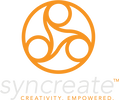As part of my PhD program in psychology / creativity studies, I recently wrote a paper exploring the relationship between creativity, learning, and education. Because education is one of our main areas of interest at Syncreate, I thought I’d share some of my explorations here in the blog.
My paper explored three main ideas: 1) the educational process consists of a creative, dynamic, and ongoing negotiation between individuals and their worlds, 2) connection, interdependence, and relationship lie at the heart of meaningful learning, and 3) creativity, imagination, and the process of making meaning underlie the most profound learning experiences. In my experience teaching writing and religious studies at the college level, the most powerful educational moments for students (and for me) are those that that foster a process of active meaning making. They are those that ask students to draw upon, but also to investigate and question, their own experiences, and to actively consider how course material relates to their own lives. They are those that invite students to explore real-life situations and events outside of the classroom, such as cultural performances or religious ceremonies, and to write about them in light of course themes and theories. I find that this experiential, embodied, and engaged approach to education not only evokes deep learning and insight, but also can be personally transformative for students, broadening their perspectives and worldviews, and in some cases, forever changing the way they understand and relate to their own lives.
For example, while teaching freshman composition at Tulane University in New Orleans, I developed a course called “Performing New Orleans” that paired performance theory with readings about the rich cultural and performance traditions of the city. I invited students out of the classroom and into an experiential dialogue with those traditions through visits to Preservation Hall, Mardi Gras parades, the Voodoo Spiritual Temple, and The Historic New Orleans Connection. For their final papers, I asked students to synthesize all of this theoretical, academic, and experiential knowledge and to creatively analyze of one of New Orleans’ performance traditions. Similarly, while teaching comparative religion courses at Tulane and Austin Community College, I encouraged students to attend, observe, and participate in various religious events and festivals and write about them in conjunction with the course material we were covering our course readings and discussions. For their final course task, students had the option of completing a creative project relevant to their own belief systems and life journeys, and to present these projects to one another during the final week. I conceived of this assignment as an exercise in meaning making, an opportunity for students to more deeply explore their own passions, and to create a personal shrine or altar, work of art, musical composition, performance, or multimedia presentation that expressed their deepest convictions. When students took this project seriously, they created works of incredible beauty and poignancy, which evidenced deep reflection upon course themes.
If we, as educators, began to seriously consider the relationship between learning and creativity, we would see that these two processes truly spring from the same source. Both learning and creativity involve an active, experiential, embodied, interconnected, and fully engaged process of meaning making. As this fundamental relationship between learning and creativity becomes more widely understood, I hope that educators and policy makers will begin to embrace creativity as absolutely central to the educational process.

 RSS Feed
RSS Feed
